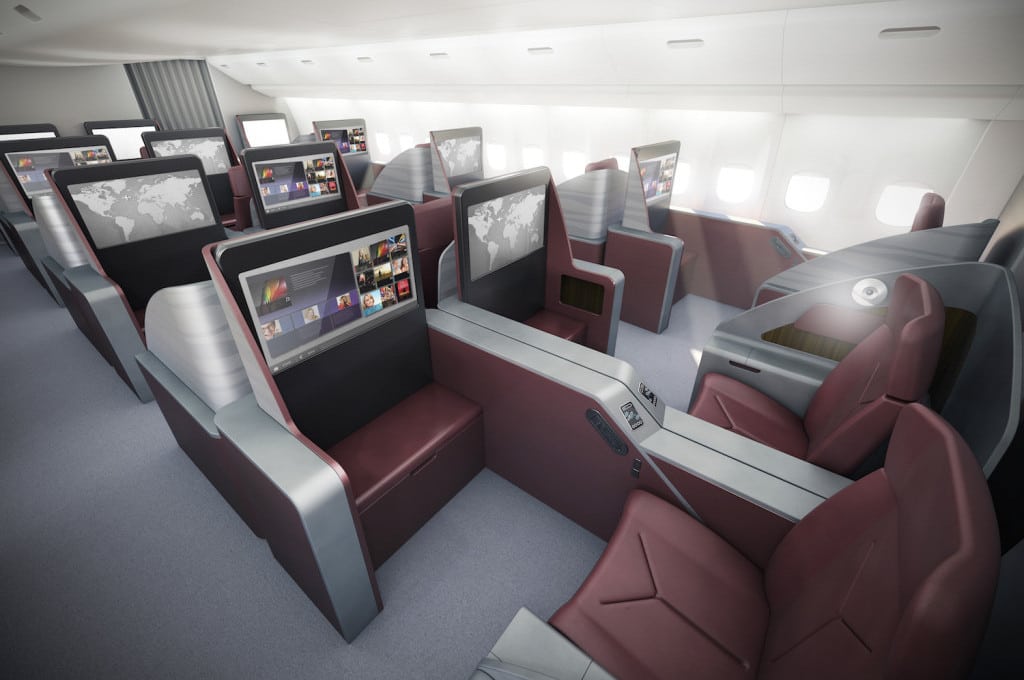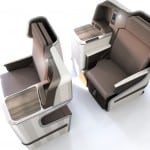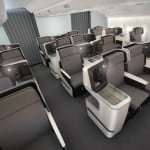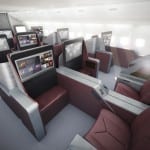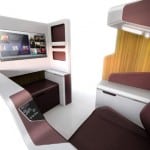Skift Take
Premium passengers may be fewer in number, but they make up a big chunk of most airlines' revenue. Even when the economy keeps leisure travellers at home, business travellers still have to fly. And the affluent can fly whenever and wherever they please.
- SOLSTYS III Seat.
- SOLSTYS III cabin rendering.
- ULTIMATE cabin rendering.
- STELIA ULTIMATE Premium seating.
The International Air Transport Association (IATA) reports that demand for premium seating on aircraft could be slowing, but you wouldn’t know it based on the focus suppliers put on designing lavish seats for these cabins, nor from our obsession with how the 1% flies.
We spoke with STELIA Aerospace, one of the sector’s top three suppliers, which has uniquely focused its business model on premium seating, and learned the company’s secrets for making comfortable, luxurious seats that can be built on time, to spec, and which sell well regardless of momentary market fluctuations.
“The market for the premium [seating] segment is growing at least 6% per year at the moment,” says Claire Nurcombe, Head of Marketing and Cabin Interiors at STELIA. “We can always grow, and we’re always looking to grow, but it’s a very good market and there’s lots of room for us to grow within it.”
STELIA Aerospace is wholly owned by Airbus Group, the company which also owns the aircraft manufacturer of the same name. But STELIA also sells to Boeing’s airline customers and STELIA seats fly on Boeing aircraft. The Airbus Group ownership, she tells us, is no guarantee of a place onboard. The decision on seats rests ultimately with the respective airline.
The company, therefore, makes its way in this specialized market by focusing on solving the problems both airlines and aircraft manufacturers face when buying premium seating: affordability, customization, and deliverables.
“We’re well know in the industry for very high quality on-time deliverables,” says Nurcombe. “Three times in the past four years, we have received an award from Airbus as the top seat supplier on the supplier rating. It’s an award we’re really proud of because this comes directly from the airlines. Airbus asks the airlines to rate their suppliers.”
While premium is all about product appeal and comfort, suppliers and designers have to balance airlines’ desires to differentiate with the limitations strict rules and regulations, and production timelines.
“You always have a tension between the customization needs and the lead-time obligations,” Nurcombe says. “If you look at a business class product, like the Solstys III, we know generally what airlines look for, so we have a number of options that we’ve developed in conjunction with our airline customers to meet their expectations.
“It’s a product that’s at the high-end of the business class product spectrum, so our customers expect a great deal of customization, however, we know that there are some programs where lead-times are a lot shorter.
“Typically, if we’re involved in that type of program, we can cut back to a slightly less customized version of the aircraft and the constraints they’re working in. We know that airlines aren’t going to want to see their aircraft delayed because of seat delivery. We work hand-in-hand with the airline to ensure that we meet their expectation of customization requirements but also in terms of quality and industrial constraints.”
To differentiate its products from large competitors offering highly attractive alternatives to customers, STELIA has held to the tenant that form should follow function. That doesn’t take passenger comfort out of the equation.
“When we talk about customization we usually mean the options that an airline takes for the seat, but we’re looking beyond that to allow the passengers themselves to customize their environments,” Nurcombe says.
The next big design trend for premium, Nurcombe explains, is developing smart cabins and smart materials that allow passengers to tailor their environment.
“You provide the space where, when you’re flying out on business you may want to work, or sleep, and you need a space that allows you to do both,” she says. “When you’re flying home from your business trip, you may need to write up your meeting notes. But after that you want to relax, watch a film, you want to enjoy the inflight meal and just sit back. It’s a totally different journey and a different need.”
Nurcombe believes that, despite the ebbs and flows in bookings, a strong market for premium air travel will endure. She also believes we’ll debating relative cabin comfort for a good long while.
“It’s an interesting subject because everybody knows what comfort is, but everyone’s idea of comfort is different. I think that’s why everyone is so passionate about this topic,” Nurcombe says.
Despite radical cabin concepts that make their rounds through the seating market, Nurcombe has a more grounded view on the progress of innovation in aviation.
“We have an industry that is, on the one hand very innovative and always looking at the latest innovation, and on the other hand extremely conservative,” she says. “[As seat suppliers] we need to find a way to meet the innovative desire of the airlines without frightening them away too much. We need to be creative while allowing this innate conservatism to work its way through.”
The Daily Newsletter
Our daily coverage of the global travel industry. Written by editors and analysts from across Skift’s brands.
Have a confidential tip for Skift? Get in touch
Tags: airbus, amenities, in-flight
Photo credit: ULTIMATE cabin rendering. STELIA Aerospace
